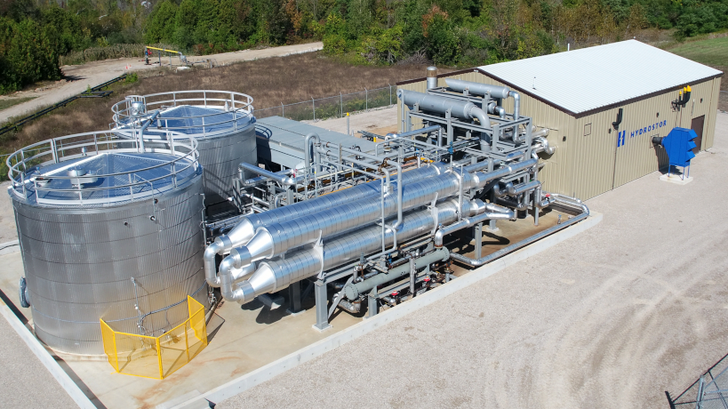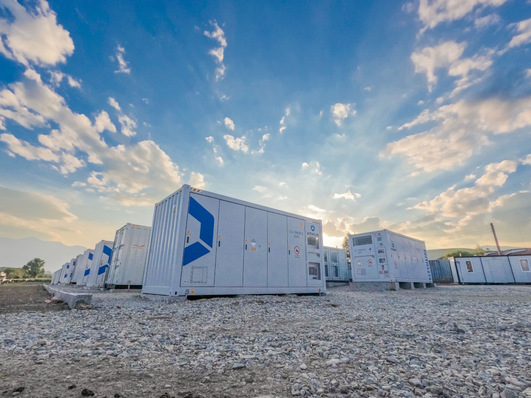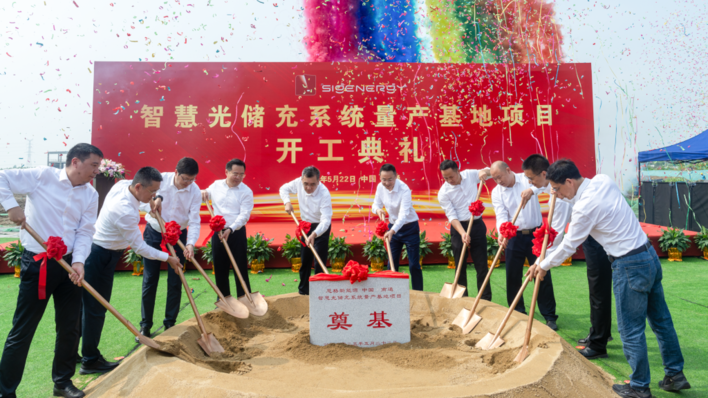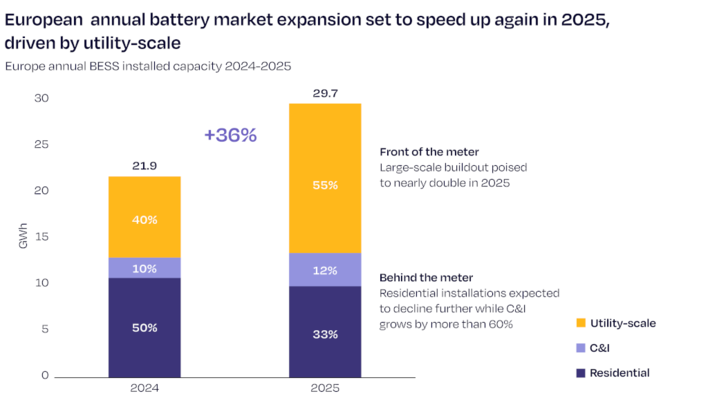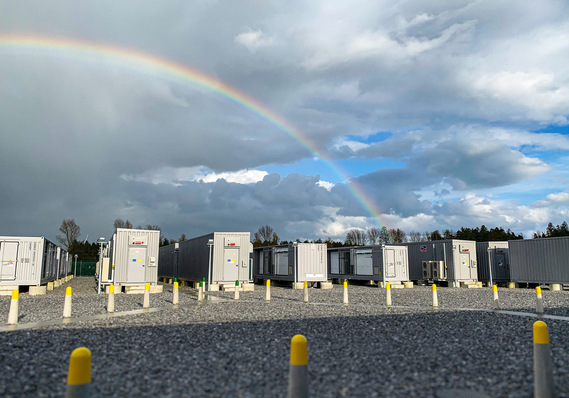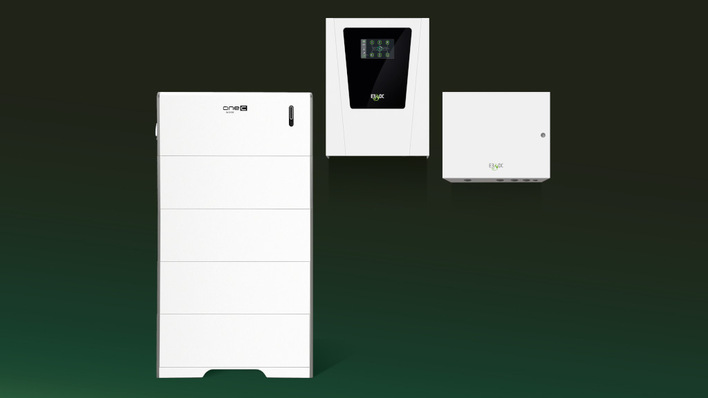Lithium-based storage systems continue to dominate the market against intensifying price wars and expanding production, and promising new technologies are emerging all the time. And so, without further ado, here are the winners:
Energy Storage category
CMBlu Energy – Organic solid-flow battery
German company CMBlu Energy has developed an innovative organic solid-flow battery that combines high performance with minimal environmental impact. Series production is planned for 2026. The long-duration storage unit holds 200 kilowatt hours and delivers an output of 40 kilowatts. Thanks to its flexible modular design, the system can be scaled up to several gigawatt hours, with storage durations spanning several days.
Designed with circular economy principles in mind, the battery contains no rare or conflict materials and is fully recyclable. Its advanced chemistry uses solid organic polymers paired with organic, metal-free electrolytes that are widely available and recyclable.
The system is rated as exceptionally safe, emitting no toxic vapours and is neither flammable nor explosive. The battery is designed for more than 20,000 charging cycles and offers a DC-to-DC efficiency of up to 90 per cent. The jury commended the technology for its energy density, chemical innovation and scalable, cost-effective design.
Hydrostor – A-Compressed Air Energy Storage (A-CAES)
Founded in Canada in 2010, Hydrostor has developed a zero-emissions compressed air energy storage system with no emissions, targeting applications in the mining sector, municipal infrastructure and utilities.
The A-CAES system stores compressed air in underground rock caverns, using water to balance pressure levels. It is designed for locations with demand-intensive grid demand and can store electricity for 8 to 24 hours. According to Hydrostor, it requires up to ten times less land and twenty times less water compared to conventional pumped hydro.
Sungrow and FRV launch Arctic-edge battery project in Finland
Energy density is achieved through hydrostatic compensation, in which a water column regulates pressure in the cavern. This sets the system apart from traditional compressed air storage by reducing the size of the underground cavity needed.
A sophisticated thermal management system captures and reuses waste heat from the compression process, enabling operation without fossil fuels. With a service life of up to 50 years and no performance degradation, the system offers robust, durable energy storage.
Samsung SDI – Uninterruptible power supply with 8C
Samsung SDI’s U8A1 battery system is designed for uninterruptible power supply (UPS) applications. Based on lithium manganese oxide (LMO) chemistry, it offers ultra-fast charge and discharge capability with excellent thermal stability. The system can deliver power for five minutes at a discharge rate of 8C, corresponding to 645 amps.
This level of performance combined with robust safety features makes it well suited to mission-critical infrastructure such as hospitals, data centres and cooling systems. The 1 MW UPS unit is exceptionally compact, requiring just 1.36 square metres of floor space.
Tesvolt and Samsung collaborate on battery cybersecurity
Samsung SDI provides a 10-year warranty and a battery life of up to 15 years, keeping maintenance and operational costs low. The jury highlighted the system’s outstanding performance, reliability and safety credentials.
Smart System Integration category
In the smart system integration category, this year’s awards spotlighted transformative digital technologies that dramatically expand the use of solar power. And the three winners are…
Fenecon – FEMS system
Fenecon’s FEMS platform autonomously monitors and controls battery systems, solar inverters, heat pumps and EV charging stations to ensure grid-friendly and energy-efficient operation. AI-based forecasting and grid monitoring enable predictive energy management and optimised charging and discharging.
Fraunhofer and HTW Berlin develop new wallbox quality score
With its flexible modular architecture, FEMS can be deployed quickly and adapted to evolving regulatory requirements. As open-source software, it receives frequent free updates. Fenecon positions the platform as a tool for a new and data-literate generation of prosumers and as a key enabler of flexible, decentralised energy networks.
Toscano – Combi Pro Max
Spanish manufacturer Toscano, with over five decades of proven experience in electrical safety, has introduced the Combi Pro Max, a refined and compact emergency power control unit for solar and storage systems. In the event of a power failure, it automatically switches to emergency or off-grid operation, maintaining supply to critical loads.
Marcus Fendt “Intelligent charging is possible immediately”
The system is designed for seamless installation in a meter cabinet using a top-hat rail enclosure. All necessary switches are integrated into a streamlined single module, and its compact format reduces both hardware requirements and cabling complexity. Compatible with a broad range of inverters, Combi Pro Max provides a pragmatic and space-saving solution for consumers looking to protect their energy supply against power failure.
Utiligize – Forecast & Investment platform
Utiligize, a Danish company founded in 2018, develops software-as-a-service solutions for electricity network operators. Its Forecast & Investment platform is designed to improve the planning and management of power grids that incorporate the rapidly increasing number of decentralised energy sources. The cloud-based tool supports operators in maximising asset use while meeting increasingly complex regulatory requirements.
At the heart of the platform are AI-based forecasting models that perform billions of calculations using data from smart meters and geographic information systems. These models enable the platform to predict local capacity constraints and voltage limits with hourly resolution, looking as far ahead as 2050.
Schletter unveils major overhaul of planning tool
This predictive insight allows grid operators to make informed and forward-looking planning and investment decisions. According to Utiligize, the platform can reduce capital expenditure by up to 35 per cent. Moreover, it is designed for seamless scalability and can accommodate new technologies such as vehicle-to-grid systems as they enter the market.
The jury highlighted Utiligize’s practical approach to grid planning, its innovative use of data, and the wide-ranging applicability of its solution, positioning it as a valuable tool for supporting an efficient and intelligent energy transition.
Congratulations to all of the winners! (HS/TF)


